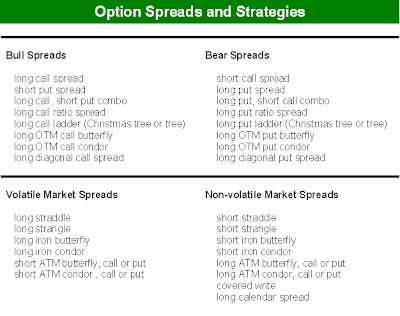
Bullish Spread - Long OTM Call Condor
Like the Long OTM Butterfly, the Long OTM Call Condor involves 4 option positions, which means, it can be costly in terms of commissions.
The easiest way to understand this bullish spread is to view it as :
Long OTM Call Spread and Short even further OTM Call Spread
The Short position helps to fund the cost of the Long OTM Call Spread.
When to use : Mild Bullish Trend
How to establish : LONG OTM Call Spread and SHORT a higher strike Call Spread
Debit or Credit : Debit
Margin Requirement : No
What is the Maximum Profit : The distance between the LONG and SHORT Strikes (limited) - debit paid
What is the Maximum Loss : Amount paid (the debit) for the spread (limited)
Example :
Amgen (AMGN) is at $58. Long 60/62.5 Call vertical is trading at 66cents. The Short 65/67.5 Call vertical is trading at 14 cents. This Long OTM Call Condor is established with a 52 cents (66 - 14) debit.
Profit/Loss Explanation :
Debit (means you pay) for Long 60/62.5 Call Spread = 0.66
Credit (means you receive) for Short 65/67.5 Call Spread = 0.14
Total Debit = 0.52
Maximum loss = 0.52
Maximum Profit = 1.98 ( 62.5 - 60 - 0.52)
Breakeven points = 60.52 and 66.98
Profit Range = anything between the breakeven points
Probability of Success = ~25%
Risk/Reward Ratio = 0.52 / 1.98 = 0.26; ie you risk 0.26 for a profit potential of 1.00
Now, note that is a limited risk position and a limited reward one as well. The risk commensurates with the chance of success almost 1 to 1 relationship; ie 25% of success and a risk of 26cents to win $1. Very fair indeed.
Remember this is a Bullish Position, minus the risk of unlimited losses on a simple LONG AMGN stock position. The trade off is that it comes with a limited profit potential. That's trading and some say, life.
P/L Chart of AMGN Long 60/62.5/65/67.5 Call Condor

I have decidedly show the GREEKS to explain this condor.
Delta
It has a +ve 7.86 delta, which is good becos we always want a +ve delta for a bullish position, which this condor is.
Gamma
What is not good is the -ve 0.32 gamma. This is not good becos the -ve gamma will shrink the +ve delta position as AMGN price rallies. However, do note that this -ve gamma will turn positive at some time in the life of this condor position, provided AMGN rallies as desired. On the flip side, this -ve gamma will help this position from losing too much value should AMGN price drop. This is bcos the -ve gamma again will shrink the delta and with every dollar drop in AMGN, this overall condor option position will also drop lesser becos of the shrunk delta.
Theta
It has a +ve 0.09 theta, small though, but always very good becos as time passes, this condor position will gain from time decay rather than lose value, which happens for option positions that have -ve theta
Vega
It has a -ve0.21 vega, which is not necessary good. This is becos AMGN is currently at $58 and you will want the price to be somewhere between $60.52 and $66.98, which means you want AMGN price to MOVE. You want a +ve vega to help move the price of this condor position with increased volatility rather than a stationary AMGN volatility. Nevertheless, vega will change its polarity depending on what AMGN price is at.













